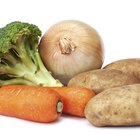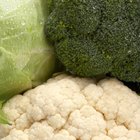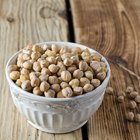
Asparagus is a nutritional superstar. While asparagus can also be boiled, roasted, grilled or stir-fried, steaming is quick, minimizes the amount of nutrients lost while cooking and doesn't require any added fat. For the best flavor, choose fresh asparagus from February to June, the peak of the vegetable's growing season.
Health Benefits
It's rich in minerals like fluoride and copper, vitamins such as vitamin K, vitamin E, thiamin and riboflavin and both soluble and insoluble fiber. Asparagus also contains more flavonoids -- compounds that may lower your risk of cancer like polyphenols -- than broccoli. It is also high in antioxidants, including vitamin C, vitamin E anf glutathione.
Serving Size
The U.S. Department of Agriculture says that, for most vegetables, a serving of raw or cooked vegetables is considered to be 1 cup. When it comes to asparagus, however, the serving size of the vegetable cooked in any manner, including steaming, is 1/2 cup. This amount is equal to six whole spears of steamed asparagus. A 1/2-cup serving of steamed asparagus is also equivalent to 1 cup of broccoli or carrots, 2 cups of raw leafy greens such as spinach or romaine lettuce, an ear of corn or 1 cup of vegetable juice.
Nutrition Facts
One spear of asparagus has approximately 0.6 carbs, meaning one cup of steamed asparagus spears is going to have around give grams of total carbohydrates. The recommended daily value of carbs in a 2,000 calorie diet ranges from 900 to 1,300 calories from carbs. This is equal to 225 grams to 325 grams, so having a cup or two of steamed asparagus (without any oils or flavoring) will hardly impact that.
Once you move to cooked asparagus, which is usually cooked in some kind of oil and sprinkled with spices or other flavors, the total fat value, calorie count and carbohydrate total will most likely increase. This is why steaming asparagus is the healthiest option, and even helps lower your cholesterol levels.
Vegetables and other whole foods are always going to be good for digestion compared to process foods, but super greens like asparagus can greatly contribute to weight loss efforts when used effectively. Talk to a nutritionist about how to work in veggies and other super foods into your diet in realistic, tasty ways if you need assistance.
Recommended Intake
According to the USDA's ChooseMyPlate.gov, at least half of a healthy meal should consist of produce. When selecting vegetables, you're advised to try to pick a variety each day from the five subgroups: beans and legumes, dark green vegetables, starchy vegetables, red and orange vegetables and other vegetables. Asparagus falls into the "other" vegetable category. Adult women should have about 2 1/2 cups of vegetables each day, while children need between 1 1/2 to 3 cups depending on their age, gender and level of physical activity. For a woman, a 1/2-cup serving of steamed asparagus would fulfill nearly half of her daily vegetable recommendation.
Steaming Methods
You can use a steamer basket or a steamer pot to prepare steamed asparagus, but you can also get the job done with just a stockpot that has a tightly fitting lid, says Bon Appetit. Put a few ounces of water into the pot and bring it to a boil. Add the asparagus in the steamer insert, if you have one, or arrange the stalks standing on end in the pot. Cover and allow the asparagus to steam for between three and eight minutes, or until the thickest part of the stalk is easily pierced with a knife. To serve the asparagus chilled, have a bowl of ice water ready that you can quickly plunge the steamed stalks into.
Serving Suggestions
A serving of steamed asparagus is classic paired with grilled or roasted fish, poultry or lean steak, but don't limit yourself to that. Use chopped, steamed asparagus on salads, mixed into pasta or as a substitute for parsley in pesto. Get your kids into asparagus by serving chilled, steamed asparagus stalks with dipping sauces like honey-mustard or low-fat ranch dressing. To maximize the health benefits, steer clear of high-fat butter or hollandaise sauces as an asparagus topping; instead, use fresh lemon juice, spices, herbs or a drizzle of olive oil.
Related Articles

List of High Protein Vegetables

Vegetables That Are Considered to Be ...

How Much Vegetables Per Day Can I Have ...

How to Freeze Fresh Asparagus

What Is the Nutritional Value of ...

Nutrition Information on Blueberries

Do Baked Potatoes Have a Lot of Fiber?

Top Vegetables With Selenium

How Many Calories Are in an 8-Ounce ...

How Much Whole Grain Should You Eat a ...

Do Boiled Vegetables Still Have Fiber?

Vegetables to Eat While on the Medifast ...

How to Parboil Artichokes
Nutrition Information of Jewel Yams

How to Steam Cauliflower & Broccoli

How to Perfectly Cook Broccoli

How to Cook Mixed Greens

How to Steam Vegetables in an Electric ...

List of Vegetables That Contain Protein ...

How to Juice a Daikon Radish
Writer Bio
Michelle Kerns writes for a variety of print and online publications and specializes in literature and science topics. She has served as a book columnist since 2008 and is a member of the National Book Critics Circle. Kerns studied English literature and neurology at UC Davis.